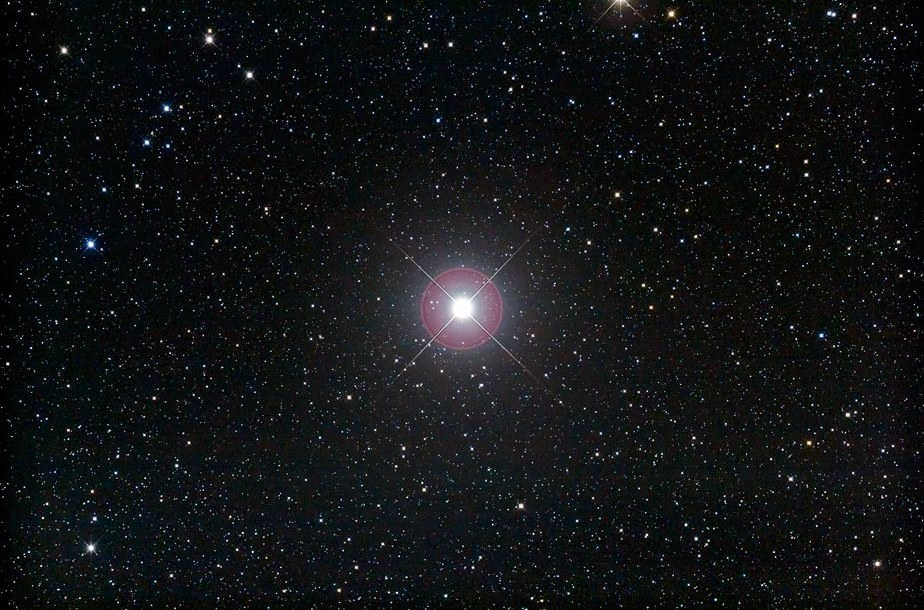
Pollux, also known as beta Gemini, is an exceptional star. It is renowned for being the most brilliant star in the Gemini constellation. However, some argue that labeling it as a beta star is a logical fallacy.
Overview
Pollux, also known as Beta Gemini, is the most luminous star in the Gemini constellation and the 17th brightest star in the night sky. It derives its name from one of the legendary twin gods, the Dioscuri – Pollux (or Polideuces in Latin). According to Greek mythology, Castor and Pollux were the twin sons of Zeus and Leda.
Resources on the subject
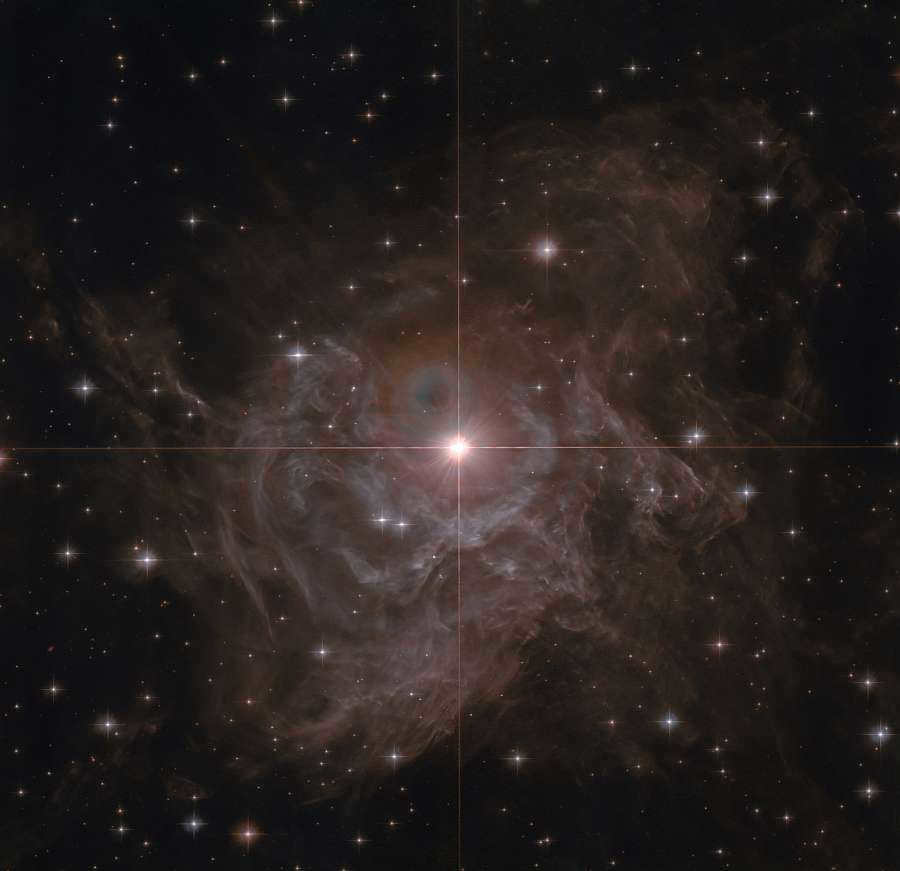
During their lifetimes, they accomplished numerous remarkable deeds. Additionally, they served as members of the crew aboard the ship Argo. Unsurprisingly, the ancient Greeks decided to honor them by naming two visually adjacent bright stars after them.
As per Johann Bayer’s classification, the renowned German astronomer who suggested labeling the brightest stars in constellations with Greek alphabet letters, the star Pollux has been mislabeled. Consequently, following Bayer’s concept, the brightest star in the constellation should have been designated with the first letter of the Greek alphabet – alpha. The other stars would then be labeled with descending letters (beta, gamma, delta, etc.). However, in the case of Pollux, Bayer disregarded his own rule and assigned the letter beta to the brightest star in the Gemini constellation.
Nevertheless, it is not common knowledge that Bayer’s classification system includes two factors. The primary criterion is the level of brightness. However, when faced with the scenario of two stars possessing the same level of brightness and being in close proximity, Bayer opted to prioritize the star that is more northerly. As a result, he assigned the label “alpha” to Castor, which is the second brightest star in the Gemini constellation and the 23rd brightest star in the entire night sky. The reason behind this decision is that Castor is situated significantly further north than the brightest star in the Gemini constellation, Pollux.
Characteristics of matter

Pollux, also known as Beta Gemini, is a small orange star classified as K0 IIIb. Its luminosity is a mere 32 times that of our Sun. With a mass of 1.86 solar masses, Pollux would not be considered one of the brightest stars visible from Earth if it weren’t for its proximity to our planet. As of 2011, Pollux is located just 40 light-years away from Earth, which is relatively close in astronomical terms.
Pollux has only one thing to be proud of – its radius. As per the most recent information, its radius is eight times greater than that of our Sun. Nevertheless, it is anticipated to gradually expand as Pollux undergoes a transformation into a red giant. Astronomical calculations propose that the star will deplete its helium reserves in approximately 100 million years, leading Beta Gemini to evolve into a white dwarf.
Conditions for observation and intriguing details
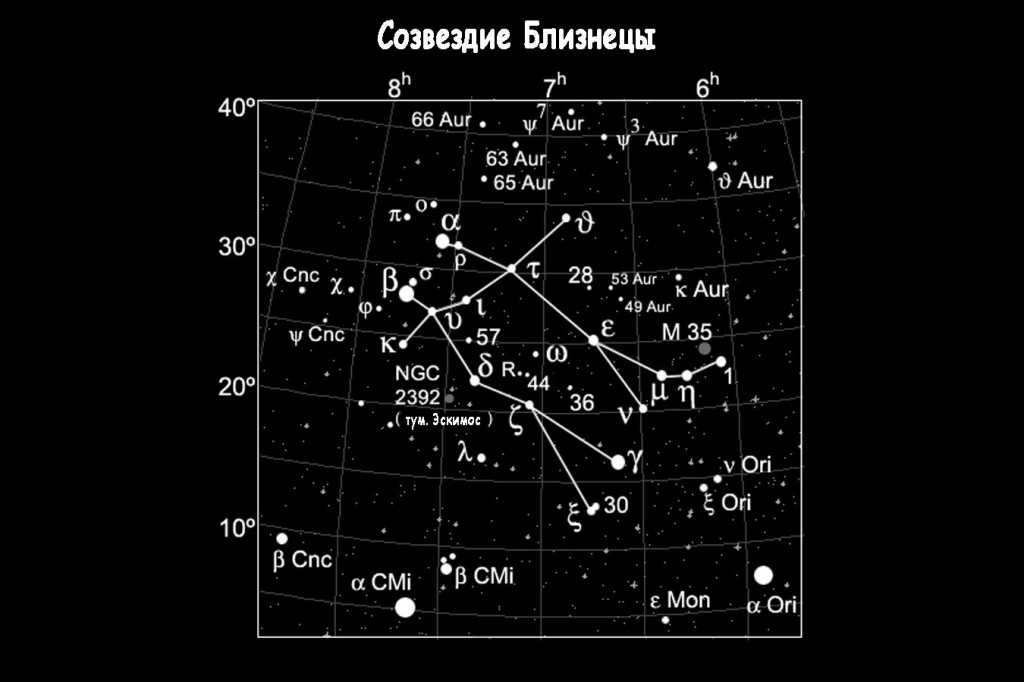
The constellation Gemini, along with its most prominent star, Pollux, is a celestial formation located in the Northern Hemisphere. It can be easily observed in Russia. This group of stars is best viewed during the months of December and January, just like its two brightest stars, Pollux and Castor.
Pollux is a star that exhibits varying levels of luminosity. Its luminosity can range from 1.10m to 1.17m.
According to the latest astronomical data, it has been confirmed that Pollux possesses an exoplanet in orbit around it at a distance of 1.69 astronomical units, with a complete orbit taking approximately 590 Earth days.
Compilation of the most luminous stars
No Title Distance in light-years Apparent Magnitude Absolute Magnitude Spectral Class Hemisphere| 0 | Sun | 0.0000158 | −26.72 | 4.8 | G2V | |
| 1 | Sirius (α Canis Majoris) | 8.6 | −1.46 | 1.4 | A1Vm | Southern |
| 2 | Canopus (α Carinae) | 310 | −0.72 | −5.53 | A9II | South |
| 3 | Alpha Centauri | 4.3 | −0.27 | 4.06 | G2V+K1V | South |
| 4 | Arcturus (α Boötis) | 34 | −0.04 | −0.3 | K1.5IIIp | North |
| 5 | Vega (α Lyrae) | 25 | 0.03 (perm) | 0.6 | A0Va | North |
| 6 | Capella (α Aurigae) | 41 | 0.08 | −0.5 | G6III + G2III | North |
| 7 | Rigel (β Orionis) | ~870 | 0.12 (perm) | −7 | B8Iae | South |
| 8 | Procyon (α Canis Minoris) | 11.4 | 0.38 | 2.6 | F5IV-V | North |
| 9 | Alpha Eridani | 69 | 0.46 | −1.3 | B3Vnp | South |
| 10 | Betelgeuse (α Orionis) | ~530 | 0.50 (perm) | −5.14 | M2Iab | North |
| 11 | Hadar (β Centauri) | ~400 | 0.61 (perm) | −4.4 | B1III | South |
| 12 | Altair (α Aquilae) | 16 | 0.77 | 2.3 | A7Vn | Northern |
| 13 | Acrux (α Crucis) | ~330 | 0.79 | −4.6 | B0.5Iv + B1Vn | South |
| 14 | Aldebaran (α Tauri) | 60 | 0.85 (rem) | −0.3 | K5III | North |
| 15 | Antares (α Scorpii) | ~610 | 0.96 (perm) | −5.2 | M1.5Iab | South |
| 16 | Spica (α Virginis) | 250 | 0.98 (perm) | −3.2 | B1V | Southern |
| 17 | Pollux (β Geminorum) | 40 | 1.14 | 0.7 | K0IIIb | Northern |
| 18 | Fomalhaut (α Piscis Austrini) | 22 | 1.16 | 2.0 | A3Va | Southern |
| 19 | Mimosa (β Crucis) | ~290 | 1.25 (perm) | −4.7 | B0.5III | South |
| 20 | Deneb (α Cygni) | ~1550 | 1.25 | −7.2 | A2Ia | Northern |
| 21 | Regulus (α Leonis) | 69 | 1.35 | −0.3 | B7Vn | Northern |
| 22 | Adhara (ε Canis Majoris) | ~400 | 1.50 | −4.8 | B2II | South |
| 23 | Castor (α Geminorum) | 49 | 1.57 | 0.5 | A1V + A2V | Northern |
| 24 | Gacrux (γ Crucis) | 120 | 1.63 (perm) | −1.2 | M3.5III | South |
| 25 | Shaula (λ Scorpii) | 330 | 1.63 (perm) | −3.5 | B1.5IV | Southern |
This post was written on May 26, 2015
By: Maxim Zabolotsky

Astronomy
When it comes to the zodiac class, many individuals have limited knowledge about the constellation Gemini. Nonetheless, astronomers have gathered a plethora of fascinating facts and information about this stellar cluster since its discovery. Currently, scientists are well-informed about the majority of the features, celestial bodies, and other captivating aspects directly associated with Gemini.
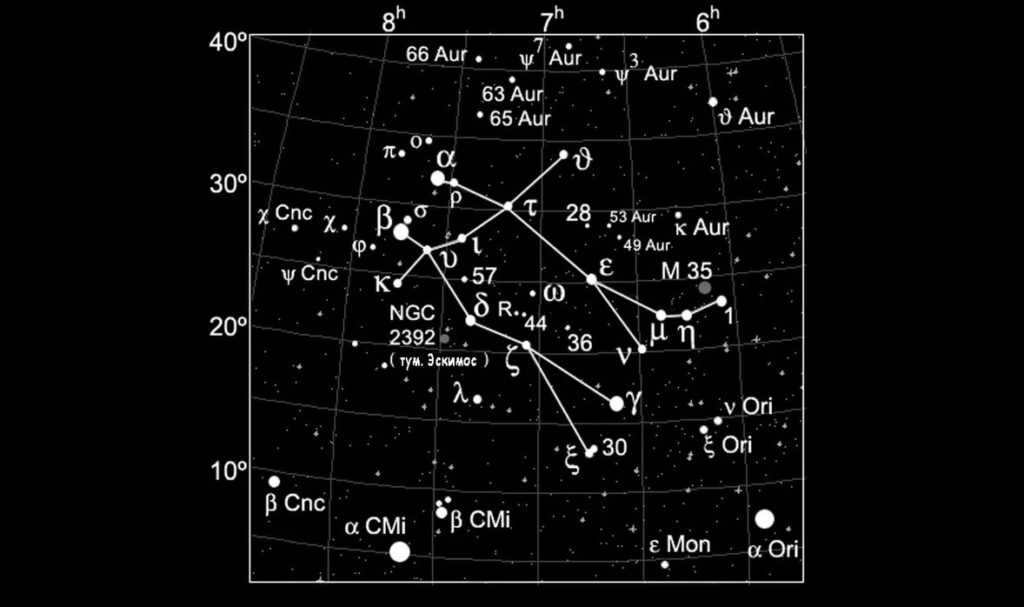
The constellation Gemini is relatively small when viewed from Earth, covering an area of only 515 square degrees in the sky. It is located in the second quadrant visible from the northern hemisphere, occupying latitudes between 60 and 90 degrees. Gemini is bordered by the constellations Chariot, Cancer, Little Dog, Orion, Lynx, Unicorn, and Taurus.
Fascinating fact: Gemini ranks 30th in size among the zodiacal constellations, placing it behind many others.
The star map of Gemini includes the cluster M 35, as well as seven bright stars around which planets orbit. Two meteor streams also pass through this region. The best time to observe this collection of celestial bodies is from December 13 to 17, when they are most prominent.
Distinctive Features of the Gemini Constellation

As previously mentioned, astronomers have extensively studied this celestial formation and have been able to determine its properties with a high degree of accuracy. The primary characteristics of the Gemini constellation are as follows:
- In Latin, the constellation is referred to as Gemini, and it is commonly abbreviated as Gem;
- The symbol associated with Gemini is Gemini;
- The right ascension of this celestial formation occurs between 5:53 a.m. and 8:00 a.m.; and
- The declination of the Gemini constellation ranges from +10 degrees to +35 degrees and 30 minutes;
- The Gemini constellation covers an area of 514 square degrees;
- The two meteor streams located between the stars are known as the Rho-Heminids and the Geminids;
- Adjacent to Gemini, you can find the constellations: Ascendant, Lynx, Taurus, Orion, Unicorn, Cancer, and Little Dog.
These characteristics aid astronomers in easily locating objects in the night sky. This process is particularly simplified during the period from December to January, when the object reaches its peak brightness in European countries.
Debunking the Myth about the Gemini Constellation
The Gemini constellation, like many others in Greek mythology, has its origins in ancient stories and is named after specific heroes. This particular star cluster holds great significance in the ancient Greek tales.
It is believed that the constellation is named after the brothers Polydeucus and Castor. These brothers were born to Queen Leda, the wife of King Tindareus of Sparta. According to the myth, Polydeucus was the son of Zeus, who disguised himself as a swan to charm Queen Leda. Eventually, she gave birth to a son and a daughter named Helen, who would later become famous as Helen of Troy. Castor, on the other hand, was the son of King Tindareus and did not possess any divine powers.
Interesting fact: Castor played a significant role in the life of young Heracles, serving as his mentor and helping him master various weapons, including the sword.
The siblings swiftly emerged as formidable fighters and participated in numerous conflicts. They joined the Argonauts on their quest for the Golden Fleece. And when Amicus, the offspring of Poseidon, obstructed their path, Polydevk confronted one of his warriors and triumphed effortlessly, enabling the Argonauts to proceed. Poseidon was impressed by the brothers’ valor and bestowed upon them a pair of white horses as a symbol of his appreciation. Additionally, from that point forward, all sailing endeavors became effortless for them.

Castor and Polydevk were once enamored with the maidens Hilaira and Phoebe. However, it quickly became apparent that the maidens were promised to the twins Linzeus and Idas. This led to a confrontation between the two sets of twins. Unfortunately, Castor, lacking divine powers, fell victim to Linzeus’ sword. In response, Polydevk sought to avenge his brother and was prepared to fight Idas. But then Zeus intervened, using his power to strike Idas down with lightning. Realizing that Castor could not be saved, Polydevk beseeched Zeus to grant him a portion of immortality.
Zeus granted Polydevk’s plea and elevated the brothers to the heavens, where they transformed into the constellation known as Gemini. Ancient Greek astronomers depicted them in the form of two heads, with the stars Pollux and Castor serving as their representations.
It is believed that the constellation represents another pair of brothers, Heracles and Apollo, who are half-brothers and also have Zeus as their father. Ptolemy was a supporter of this interpretation, although there is no myth explaining their presence in the sky.
The primary stars of the Gemini constellation
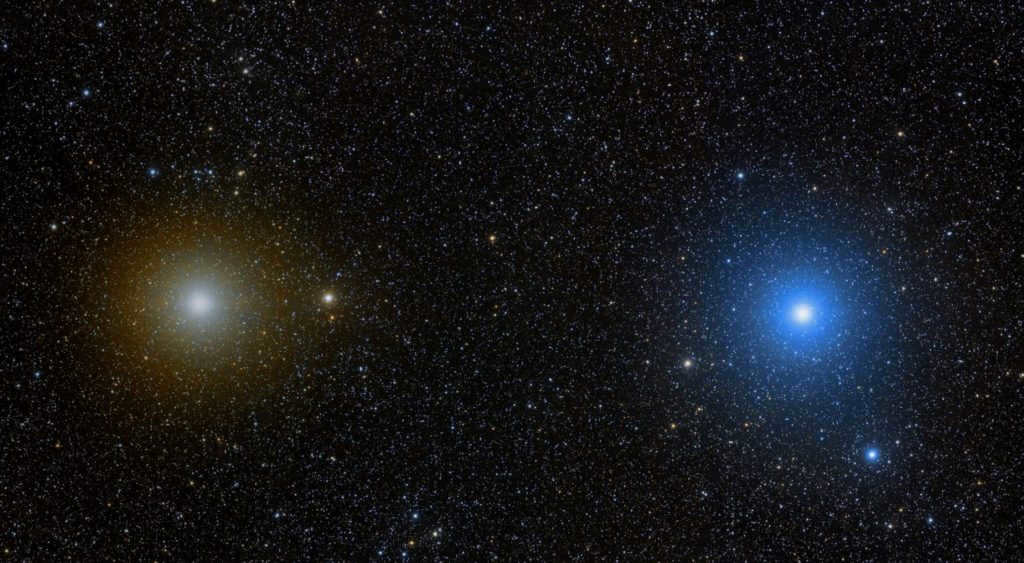
The Gemini constellation is made up of numerous stars, but the main group that stands out includes:
- Castor. This binary star is the alpha of the constellation and has an apparent magnitude of 1.58, making it the 44th brightest in the sky. Further research has revealed that Castor is actually a system of four luminaries with an orbital period of 467 years.
- Pollux. It holds the position of beta in Gemini. Pollux is an orange giant and is the brightest star in the constellation. It is nine times larger than the Sun. In the early 21st century, a planet orbiting Pollux was discovered, which was 2.3 times the size of Jupiter.
- Alchena. Known as gamma Gemini, Alchena is a subgiant star that is three times larger than our Sun and shines 123 times brighter. It is located 109 light-years away and can be easily seen without the need for special equipment.
- Mebsut. Mebsut is an epsilon star in the constellation Gemini. It is a supergiant located at a distance of 840 light years and has a brightness that is eight and a half thousand times greater than that of the Sun.
- Vasat. Vasat is a subgiant star in the constellation Gemini. It has a yellow glow and a brightness of 3.53. It is visible even to the naked eye.
- Pass. This star in the Gemini constellation is actually a triple star system located 350 light-years away from the Sun. Some astronomers classify it as a double star and a white dwarf, as it is influenced by the gravitational pull of other celestial objects.
- Mu. A pulsating supergiant star located 230 light-years away from Earth, with a brightness that gradually changes from 3.02 to 2.75, and vice versa.
While Gemini has been extensively studied, astronomers continuously discover new celestial objects within the constellation.
Known celestial objects in the Gemini constellation
Despite not being a large constellation, Gemini harbors numerous captivating objects that have captivated astronomers for an extended period. Each of these objects possesses distinctive features and properties, providing valuable insights into the structure of the universe.
Messier 35
Messier 35 is a celestial object that can be found in the night sky. It is a beautiful cluster of stars that has captured the attention of astronomers and stargazers alike. This cluster is located in the constellation Gemini and is a popular target for amateur astronomers. Messier 35 is a relatively young star cluster, believed to be around 100 million years old. It is composed of several hundred stars, with the brightest ones forming a distinct shape that resembles a letter “V”. This cluster is also known for its high concentration of blue stars, which give it a vibrant and colorful appearance. Whether you are a professional astronomer or just a casual observer, Messier 35 is definitely a sight worth seeing in the night sky.
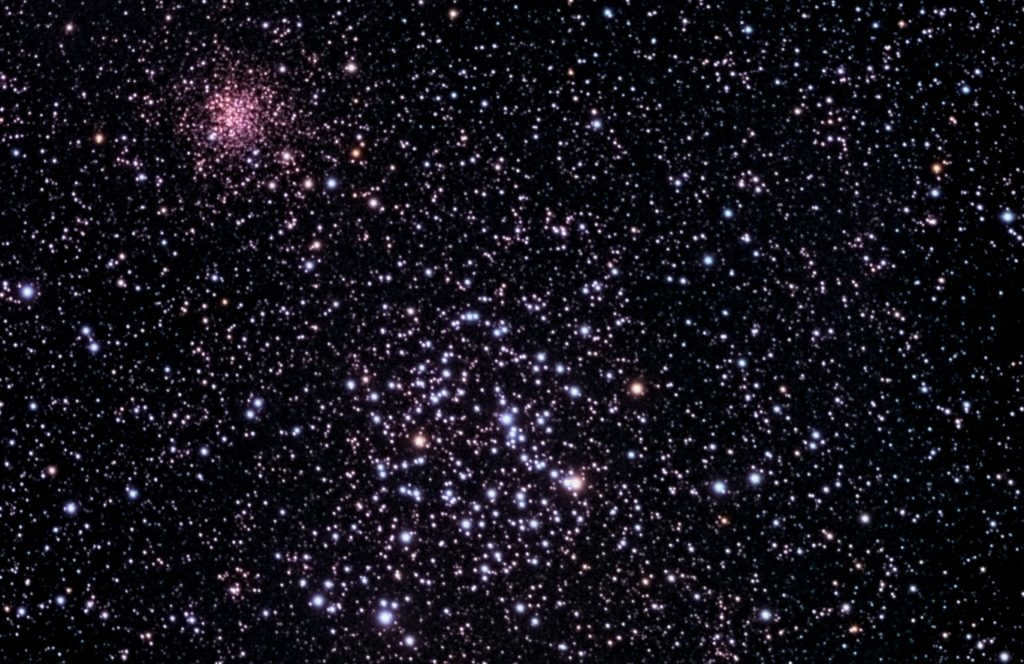
The cluster of stars is situated 2.8 thousand light-years away and has a brightness exceeding five units. Astronomer Jano de Chéseau first spotted it in 1745.
Fascinating triviaMessier 35 is approximately the same size as the Moon and covers a significant portion of the sky.
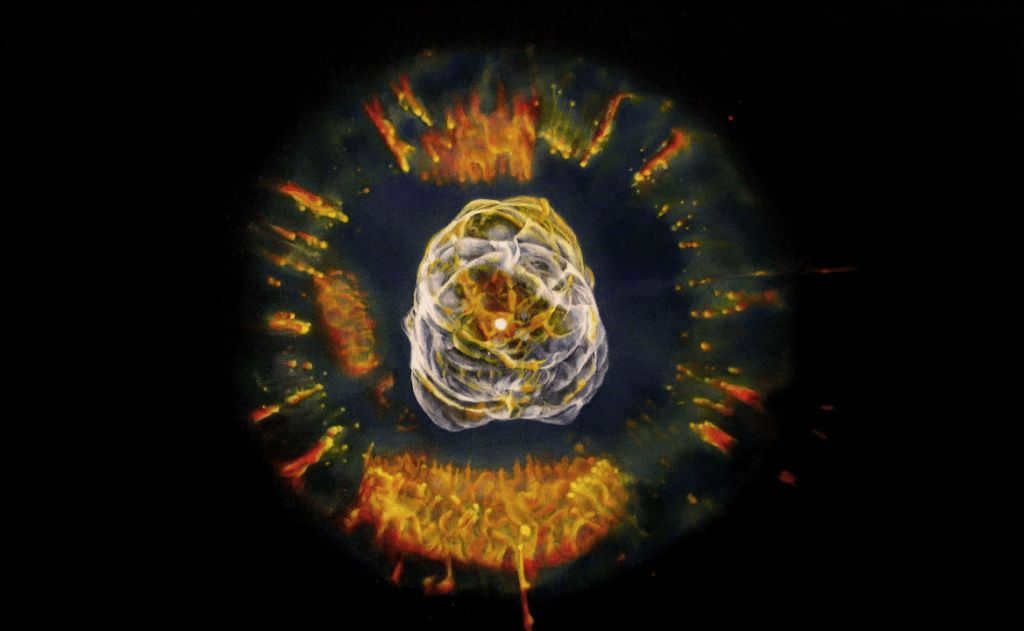
Located at a distance of 2,870 light-years from our Sun, there exists a mesmerizing celestial body with a radiant star situated right at its core. This extraordinary phenomenon harnesses the surrounding gas within the nebula, molding it into its very own distinctive structure. As a result, the object boasts a complex composition comprising numerous layers. At the heart of this ethereal spectacle, the star gleams prominently, gracefully enshrouded by a myriad of diverse clouds. This captivating nebula has earned its moniker due to its striking resemblance to the countenance of an Eskimo, enveloped by a circular fur hood.
IC 443
can be rephrased as
IC 443 Supernova Remnant
.
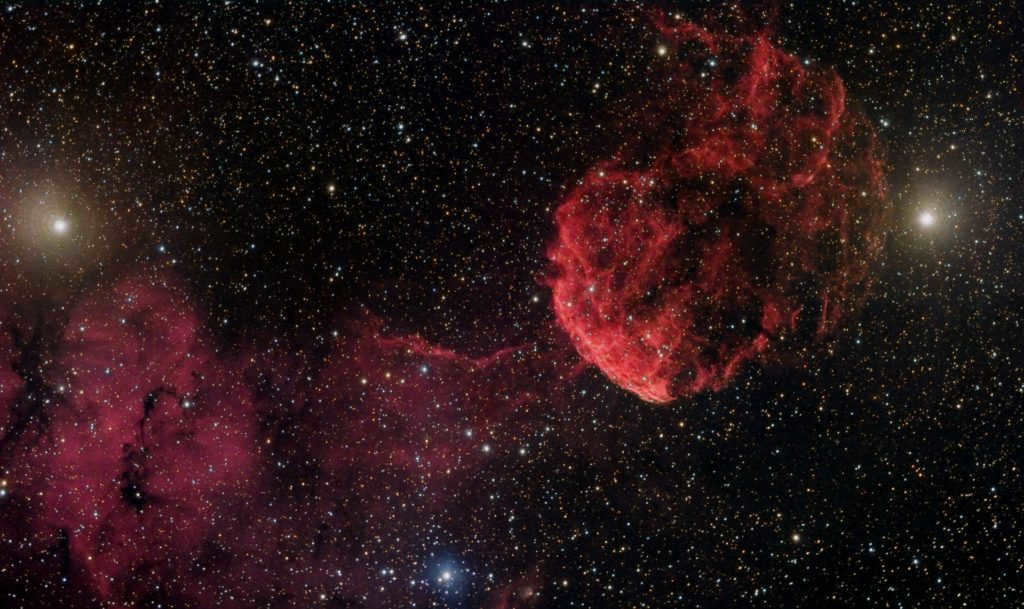
This nebula was formed by a supernova explosion approximately 15,000 years ago in the vicinity of the Eta star. Situated at a distance of 5,000 light-years from the solar system, it spans 70 light-years. Scientists theorize that the gas cluster is a remnant that is gradually dissipating into space. However, it will take a considerable amount of time for it to become invisible.
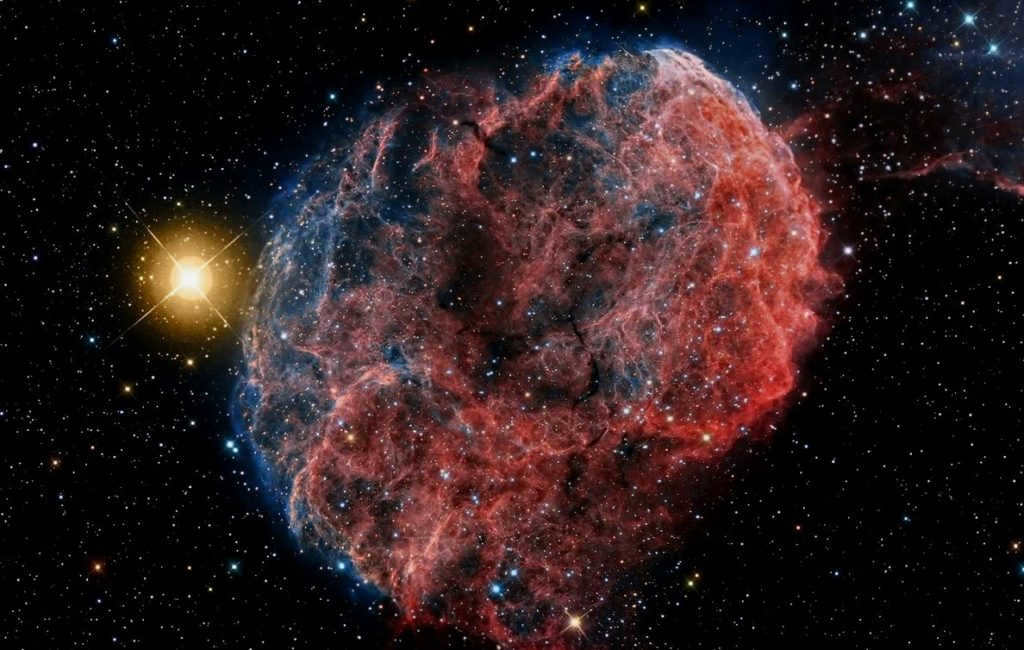
Located along the border of the Little Dog constellation, there exists a nebula that emits a captivating reddish glow. Spanning a length of four light-years, this celestial wonder demands high-quality equipment for proper observation due to its relatively low brightness. The remarkable jellyfish nebula, officially known as NGC 2371, was first discovered by George Abell in 1955.

The nebula exhibits an unusual shape: a central cluster containing planets, surrounded by two smaller clusters at some distance from the center.
Gemini Constellation in the Night Sky
This constellation is part of the winter group, as it is visible in the night sky from December to February. It first appears on the eastern horizon in the second half of autumn and then proceeds on a long journey westward over the course of several months, until it ultimately vanishes from sight for over six months.
Points of Interest in the Gemini Constellation
The constellation can be easily seen in the night sky. By looking towards its location, an individual can observe up to 70 stars without any special equipment, with about eight of them shining particularly bright.
Fascinating trivia: numerous stars within Gemini are also part of the Milky Way and play a significant role in the galaxy.
Locating a constellation in the celestial sphere
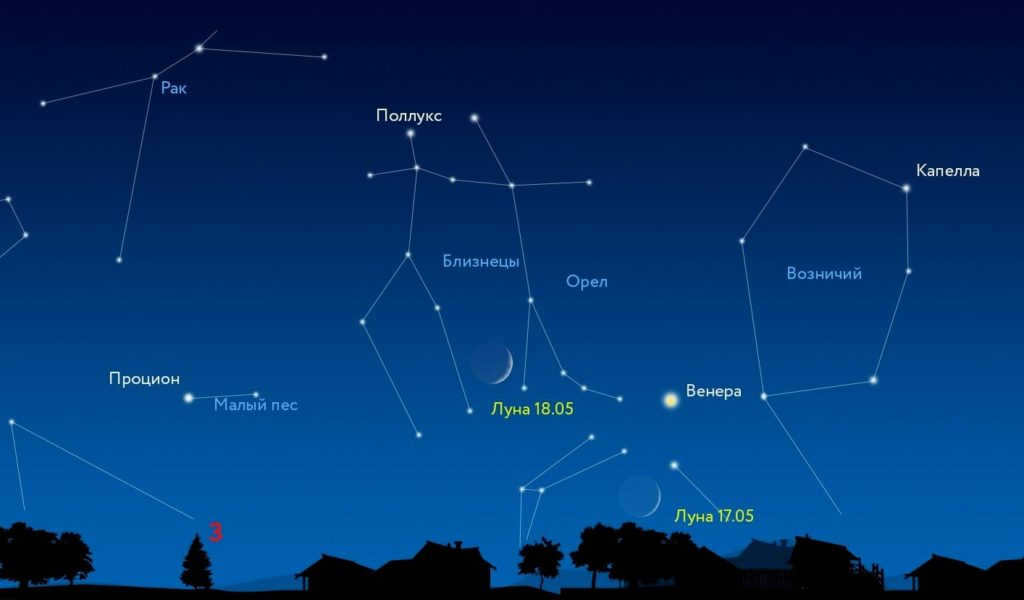
Gemini can only be seen at specific times since it is part of the zodiacal constellations. From December to May, you can observe the cluster in the sky, but in the last month, it becomes barely visible on the western horizon and eventually disappears from view.
Locating Gemini in the night sky is relatively simple. There are 14 stars with a third magnitude brightness that form straight lines, making them visible to the naked eye. If the observer spots one of the constellations bordering Gemini, they can use it as a point of reference. It is challenging to mistake Gemini for other clusters due to its rectangular shape.
Astrological Significance of the Gemini Constellation
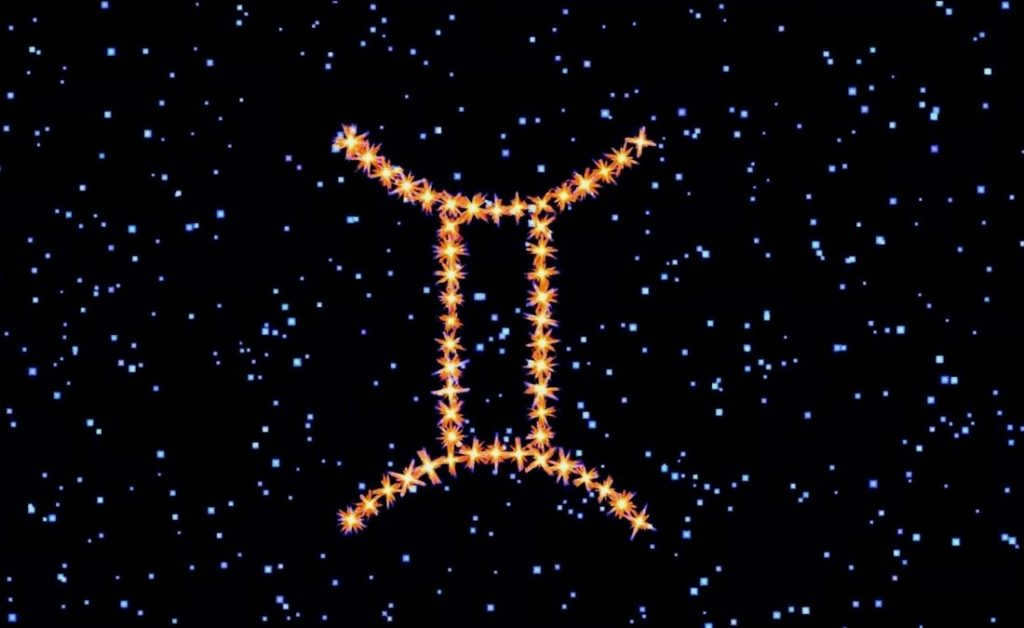
The Gemini zodiac sign is the third sign, following Taurus. It is determined based on the vernal equinox and falls between May 22 and June 21. The Sun is in the Gemini constellation from June 20 to July 20. Gemini is an air sign and is governed by the planet Mercury.
Individuals born under this zodiac sign are known for their adventurous nature and unpredictable mood swings. They are sociable and easy to get along with. Geminis are driven by ambition and constantly strive to improve their financial situation, often making plans for a successful future. They enjoy being in the spotlight and know how to use attention to their advantage.
Gemini possesses a powerful demeanor and unwavering resolve, yet they can quickly succumb to feelings of insecurity if they do not sense the backing of others. Additionally, they may easily become deeply offended by a friend if something displeases them. However, reconciling with them will prove to be a relatively effortless endeavor. When it comes to romantic relationships, Gemini selects partners based not only on physical attractiveness, but also by evaluating their character and intellectual capabilities. Unfortunately, maintaining good health is not a strong suit for them: persistent allergies and illnesses can plague them throughout their lifespan.
Fascinating video about the Gemini constellation
If you happen to come across any mistakes, kindly select the text and press Ctrl+Enter.
The Gemini constellation portrays the twin brothers Castor and Pollux, who are the sons of the queen of Sparta. Together with the legendary Argonauts, they embarked on a quest to find the golden fleece and are revered as the protectors of sailors. Interestingly, in Babylon, this same constellation was likened to a “warrior and shepherd.”
Belonging to the zodiac, the Gemini constellation holds its significance.
The stars Castor and Pollux shine the brightest in the Gemini constellation. Despite symbolizing twins, these stars are not actually related.
Due to the fact that only a limited portion of the Milky Way passes through the Gemini constellation, there is a scarcity of objects that would be of interest to astronomy enthusiasts. However, one notable object is the scattered cluster known as M35, which can be easily observed without the need for telescopic assistance.
Stars within the Gemini Constellation
 |
| Gemini constellation according to astrologer Ruslan Susi, 2010 |
The Gemini constellation is home to the following stars:
- α (Alpha Gemini, Castor: #1) is a multiple system (AO), with an age of 42 sv years. Three stars within this system can be observed using a small telescope.
- γ (Gamma Gemini, Algena – left foot of Pollux: #3) is an AO blue-white subgiant, with a lifespan of 105 million years.
- δ (Gemini Delta, Wasat – Pollux’s waist: #8) consists of a white star and an orange dwarf, and can be observed with a powerful telescope. It has a lifespan of 59 million years.
- ε (Epsilon Gemini, Mebsuta – Castor’s waist: #1) is a yellow supergiant of spectral type G8, with a lifespan of 900 million years.
- ζ (Zeta Gemini – left hip of Pollux: #13) is a variable star of spectral type F7-G3, with a period of 10.15 days. It has a lifespan of 1,200 million years.
- η (Eta Gemini, Skip: #6) is a star that has not been fully characterized yet.
- θ (Theta Gemini, left hand of Castor: #11) is a star that has not been fully characterized yet.
- ι (Iota of Gemini, Gemini conjunction: #12) is a star that has not been fully characterized yet.
- κ (Kappa Gemini, right hand of Pollux: #9) is a star that has not been fully characterized yet.
- λ (Lambda Gemini, Pollux’s right thigh: #10) is a star that has not been fully characterized yet.
- μ (Mu of Gemini, Teyat, Castor’s left foot: #4) is a star that has not been fully characterized yet.
- ν (Nu Gemini, Castor’s right foot: #15), .
- ξ (Xi of Gemini, right foot of Pollux: #7), .
- τ (Tau of Gemini, heart of Castor: #17), .
- υ (Ipsilon of Gemini, Pollux’s heart: #14), .
- 1 Gemini (also known as. Skip: #16) is a system with three stars including red and yellow giants, with a lifespan of 350 sv years. One of the components is a variable star. The telescope allows for the observation of two stars.
The constellation Gemini contains the following star systems (nebulae and clusters):
- M35 – a cluster that appears diffuse and is located 2800 light-years away.
- Eskimo Nebula (NGC 2392) is a planetary nebula that is situated 3000 light-years from Earth. When viewed through a small telescope, it appears as a bluish disk. To observe its details, a more powerful instrument is required.
- Jellyfish Nebula (IC443) – A nebula located 5000 light-years away. It is a faint supernova remnant that can be observed using a large telescope.
Articles about the Gemini Constellation
As mentioned in the terms and conditions: ◀ ◀ ◀ ◀ Place for sponsored links (please refer to the terms and conditions) ▶ ▶ ▶ ▶ –>
Keywords for discovering information regarding the Gemini Constellation (Gemini): In Russian: zodiacal constellation Gemini, stars Castor, Pollux, Algena, Vasat, Mebsuta, Propus.; In English: Gemini constellation, Gem.
Gemini is a celestial formation situated in the northern hemisphere. Gemini is the Latin translation of the word Gemini.
It is classified as one of the zodiacal constellations and was initially documented in the second century by Ptolemy. In accordance with mythology, it symbolizes the twins Castor and Polydeucus (Dioscuri).

Facts, Position, and Map
The constellation Gemini is the 30th largest constellation, covering an area of 514 square degrees. It is located in the second quadrant of the northern hemisphere (NQ2) and can be found at latitudes ranging from 90° to -60°. Gemini is adjacent to the constellations Taurus, Orion, Unicorn, Lynx, Little Dog, Cancer, and Ascendant.
Within the zodiacal constellation Gemini, you can find the Messier object known as star cluster M 35 (Messier 35, NGC 2168), as well as 7 stars that have planets. The brightest star in Gemini is Pollux, which has an apparent magnitude of 1.14. Two meteor streams, known as the Geminids and Rho Geminids, can also be observed in this constellation. These meteor showers peak between December 13th and 17th. Gemini is a part of the larger Zodiac group, which includes the constellations Aries, Taurus, Cancer, Leo, Virgo, Libra, Scorpio, Sagittarius, Capricorn, Aquarius, and Pisces.
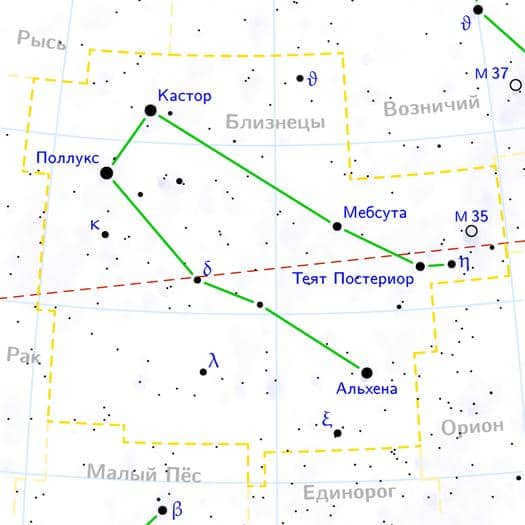
The Legend of the Gemini Constellation
The constellation Gemini features the mythical brothers Castor and Polydeucus, also known as the Dioscuri, who were the sons of Zeus. However, some versions of the story only attribute Polydeucus to the divine lineage, while Castor is believed to be the son of the Spartan king Tyndareus. According to legend, they were born to Tyndareus’ wife Leda, who was seduced by Zeus in the form of a swan. As a result, Leda became pregnant with Polydeucus and Helen, who would later become famous as Helen of Troy. Castor and Clytemnestra, on the other hand, were mortal as they were born from a mortal king.
Castor and Polydevcus grew up together and formed a strong bond. Castor excelled in horseback riding and was unbeatable in fencing. Legend has it that he even taught Hercules these skills. On the other hand, Polydevk was a skilled boxer. Both of them joined the Argonauts on their quest for the golden fleece. Polydevk proved his worth when the Argonauts were blocked from entering by Amicus, who challenged them to a boxing match. Polydevk emerged victorious without breaking a sweat.
However, this was not the only instance where the crew’s abilities saved the day. They were also considered the patron saints of sailors, believed to have received their gifts from the sea god Poseidon himself. Poseidon also blessed them with two magnificent white horses.
The Dioscuri are also linked to St. Elmo’s fire, an electrical occurrence that occurs during a thunderstorm (when a corona discharge from a sharp object in a strong electric field creates a glowing plasma). This characteristic was named after another guardian saint of sailors, St. Erasmus. Observing a developing fireball in the atmosphere, the sailors believed that the saint was present nearby.
The constellation Gemini is represented by the two brightest stars, Castor and Pollux, which are said to symbolize the heads of the brothers. However, there are different interpretations of this constellation. Hyginus and Ptolemy, for instance, believed that the two stars represented Apollo and Heracles, who were half-brothers and sons of Zeus. In the image below, you can see the bright stars and get an idea of the myth associated with the constellation Gemini.

The constellation Gemini (1690).
The primary stars of the constellation
In the image of the Gemini constellation, you can observe the stars. Let’s explore more about their description, attributes, and position.
Castor (Alpha Gemini) is a binary star that can be seen with the naked eye and has an overall apparent magnitude of 1.58. It is the second brightest star in the constellation and the 44th brightest star in the sky. The two objects are separated by a distance of 6" and complete one orbit every 467 years.
Individually, each star in the Castor system is a spectroscopic double star, making Castor a four-star system. Additionally, it has a faint companion that is located 72" away. This companion star is an eclipsing double star system, completing one orbit in less than a day.
Both objects are red dwarfs (type M). To summarize, Castor is a system of six stars (all 6 components are gravitationally bound). The third star is a variable star and is known as YY Gemini.
The main star is classified as an A1 V star, while its companion is an M5 V star. The secondary stars are classified as A2 Vm and M2 V stars. Castor is located 51 light-years away from us. In Arabic culture, it was referred to as the “Head of the Great Gemini.”
Pollux (Beta Gemini) is an evolved orange giant star (type K0 III) with a visual magnitude of 1.14. It is located 33.78 light years away. It is the brightest star in the Gemini constellation and the 17th brightest star in the sky. It has twice the mass of the sun and 9 times its radius. It is also sometimes known as the “Head of the Second Gemini.”
In June 2006, scientists observed an exoplanet circling Jupiter that has a mass 2.3 times greater than Jupiter. This exoplanet, known as Pollux b, completes one orbit around Jupiter every 590 days.
Alchena, also known as Gemini Gamma Gemini, is a white subgiant star with a mass of 2.8 times that of the Sun and a radius 3.3 times greater than the Sun. It has a visual magnitude of 1.915, making it 123 times brighter than the Sun and visible to the naked eye. Alchena is located 109 light-years away from Earth.
The name “Alhena” is derived from the Arabic word Al-Hana, which means “branding” or “marking” on the neck of a camel. It is sometimes referred to as “Almeisan,” which comes from the Arabic word Al-Maisan, meaning “the shining one.”
Mebsut (Epsilon Gemini) is a massive star (G8 Ib) with a brightness of 3.06 and a distance of 840 light-years. It is incredibly bright, shining 8,500 times brighter than the Sun, and it is also much larger and more massive, with 19 times the mass and a radius 105-175 times larger. Mebsut is located near the ecliptic and can be obscured by the Moon and planets.
This star is located in the right foot of the constellation Castor. Its name, Mebsut, comes from the ancient Arabic word Mabsula, which means “outstretched paw”. In Arabic culture, the Epsilon and Zeta stars of Gemini were seen as the paws of a lion.
Mu Gemini is a red giant star (M3 III) with a visual magnitude of 2.857 and a distance of 230 light-years. It is the fourth brightest star in the constellation. Mu Gemini is a variable star, meaning its brightness changes over time. It has a slow and irregular type of variability, with its luminosity varying between magnitudes 2.75 and 3.02 over a period of 72 days. There are also long-term changes in brightness that occur over a period of 2000 days.
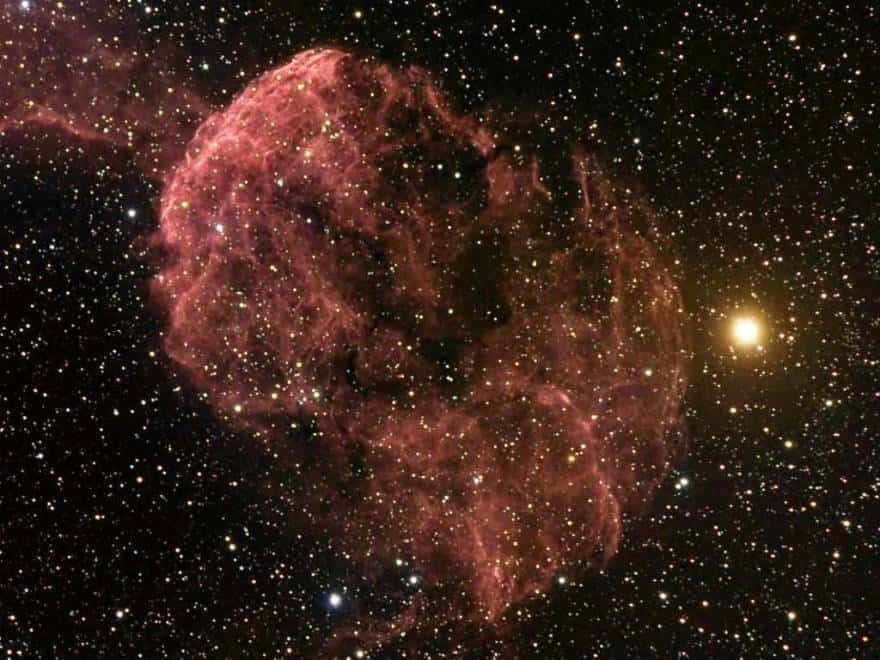
The burst of light from supernova IC 443, accompanied by the presence of Mu (on the right) and Eta Gemini (on the left) stars, is a remarkable sight. Additionally, the image captures the diffuse emission coming from S249 in the north and the partial envelope of G189.6+3.3 at the center.
Propus, also known as Eta Gemini, is an intriguing triple star system located 350 light-years away. It consists of a spectroscopic double star and a dwarf star (G0) that orbits the pair every 700 years. Due to its proximity to the ecliptic, Propus can be occulted by the Moon or planets.
At the heart of this system is a semi-regular variable star that undergoes changes in brightness over a 234-day period. This star is a red giant classified as M3IIIlab, and its magnitude varies between 3.15 and 3.9. The second component in this system is a star (B) with a period of 8.2 years.
Xi Gemini, also known as Alzirr, is a bright yellow-white subgiant star (F5 IV) located in the Gemini constellation. It has a visual magnitude of 3.35 and is situated approximately 58.7 light years away from Earth. With a brightness that is 11 times greater than the Sun, Xi Gemini is easily visible to the naked eye.
This star is known for its rapid rotation, reaching speeds of up to 66 km/s. It is believed to be a spectroscopic binary, meaning it is part of a double star system.
Vasat, also known as Gemini Delta, is another yellow-white subgiant star (F0 IV) in the Gemini constellation. It has a visual magnitude of 3.53 and is visible to the naked eye. Located approximately 60.5 light-years away, Vasat is positioned south of the ecliptic and can sometimes be obscured by the Moon and planets.
In an interesting historical note, American astronomer Clyde Tombaugh discovered Pluto just 0.5° east of Vasat in 1930.
It is a system of three stars. The stars closest to each other form a double system that can be observed using a spectroscopic method. They orbit around each other with a period of 6.1 years. Additionally, there is a companion star of K-class that orbits around the double system once every 1200 years. This companion star can be seen using a small telescope.
The system has a rotation speed of 129.7 km/s and is estimated to be around 1.6 billion years old. In approximately 1.1 million years, the system will be located within 6.7 light years of the Sun. The star is known as Wasat, which means “middle” in Arabic. In China, it is referred to as Ta Tsun.
Kappa Gemini is a multiple star of type G8 IIIa. It is located at a distance of 143 light-years from our system. With an apparent magnitude of 3.57, it is 78 times brighter than the Sun.
Lambda Gemini is a variable star of type A3 V. It has an apparent magnitude of 3.58 and is located 94.3 light-years away. It is 28 times brighter than the Sun and has a radius 2.8 times larger and a mass 2.1 times larger than the Sun. The star is estimated to be around 800 million years old.
Iota Gemini (Propus) is a star that varies in brightness (G9III) with an apparent magnitude of 3.78 and is located at a distance of 326 light years. The name Propus comes from the Latin word meaning “front paw”.
Mekbuda (Zeta Gemini) is a star that is both an intermediate supergiant and a variable star. It belongs to a class of stars known as classic cepheids. These stars are 4-20 times more massive than the Sun and can be up to 100,000 times brighter. They are typically yellow supergiants (F6-K2) and their brightness fluctuates due to pulsation periods that last from days to months.
The frequency of the pulsations is determined by the mass of the star. Over a period of 10,148 days, the luminosity of Mekbuda varies between magnitudes 3.68 and 4.16, which is equivalent to 2,900 times the luminosity of the Sun. The name “Mekbuda” is derived from ancient Arabic and means “folded paws of a lion”.
Tau Gemini, also known as K2 III, is an orange giant star located approximately 321 light-years away. With an apparent visual magnitude of 4.42, it can be easily observed under clear skies without the need for any instruments. This star is twice as massive as our Sun, has a radius 27 times larger, and shines 224 times brighter.
In addition to Tau Gemini, there is a companion object called Tau Gemini b, which is a brown dwarf with a mass equivalent to 18.1 times that of Jupiter. Discovered in 2004, this brown dwarf takes approximately 305 days to complete one orbit around Tau Gemini.
Another interesting stellar system in Gemini is U of Gemini, which is classified as a dwarf nova. It consists of a white dwarf star orbiting around a red dwarf star. Every 100 days, U of Gemini experiences flare-ups, resulting in a significant increase in its brightness. This system was first identified in 1855 by the English astronomer John Russell Hind during one of these outbursts.
The dwarfs have an orbital period of 4 hours and 11 minutes, which results in the system becoming a variable star. During each revolution, they surpass each other in brightness. The visual magnitude fluctuates between 14.0 and 15.1, but during a flare-up it can reach a brightness level 100 times greater, at 9. The orbital period is irregular and ranges from 62 to 257 days. The system is located 400 light-years away from the Sun.
Celestial objects
Messier 35, also known as NGC 2168, is a vast open cluster of stars that spans an area in the sky equivalent to the size of the full Moon. With an apparent visual magnitude of 5.30, it is visible to the naked eye. Located at a distance of 2,800 light-years, it was first discovered in 1745 by the Swiss astronomer Jean Philippe de Chézeau. Interestingly, it was also independently observed by the English physician and astronomer John Bevis in 1750.

The Roque de los Muchachos Observatory has captured the stunning images of the open star clusters Messier 35 and NGC 2158.
NGC 2158, located to the southwest of Messier 35, is an open cluster that boasts an apparent visual magnitude of 8.6 and is situated approximately 11,000 light-years away. This cluster is estimated to be around one billion years old.
The Eskimo Nebula, also known as NGC 2392 or Caldwell 39, is a mesmerizing bipolar planetary nebula featuring a double shell structure. With a noticeable apparent visual magnitude of 10.1, this celestial beauty is located at a minimum distance of 2,870 light-years from our solar system.
Back on January 17, 1787, the renowned British astronomer William Herschel first observed the Eskimo Nebula. At that time, Herschel perceived it as “a 9th magnitude star with a rather bright middle, whose nebula is equally diffuse”.
The Clown Face Nebula is encompassed by a gas layer that contributes to the formation of the Sun-like star’s outer layers. This phenomenon is occasionally referred to as the Clown Face Nebula and is observable even through a modest telescope.
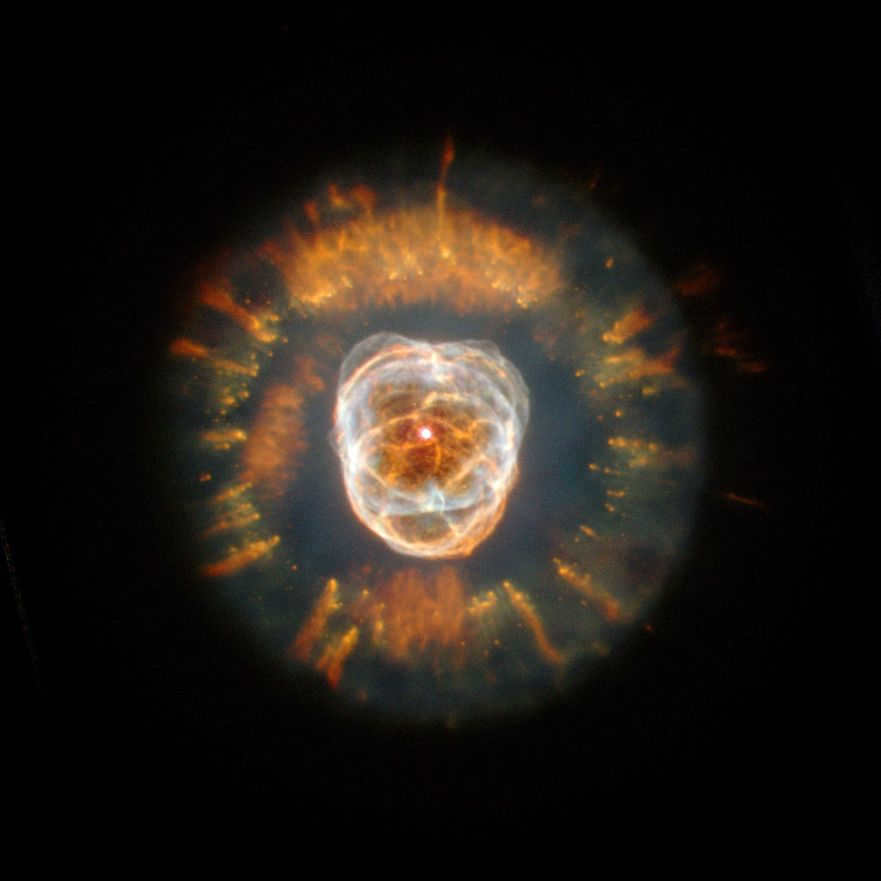

The Eskimo Nebula (NGC 2392) was captured by the Hubble telescope in December 1999. It is referred to as the "Eskimo" because it appears to have a face surrounded by a fur parka when observed through ground-based telescopes.
IC 443 (Sharpless 248) is the leftover of a galactic supernova located 5,000 light-years away. You can locate it in close proximity to the luminous star Eta Gemini. It is also commonly known as the Jellyfish Nebula. Experts speculate that the supernova occurred between 3,000 to 30,000 years ago. The remnant spans up to 70 light-years in diameter. Additionally, the explosion gave rise to a neutron star (Type II supernova).
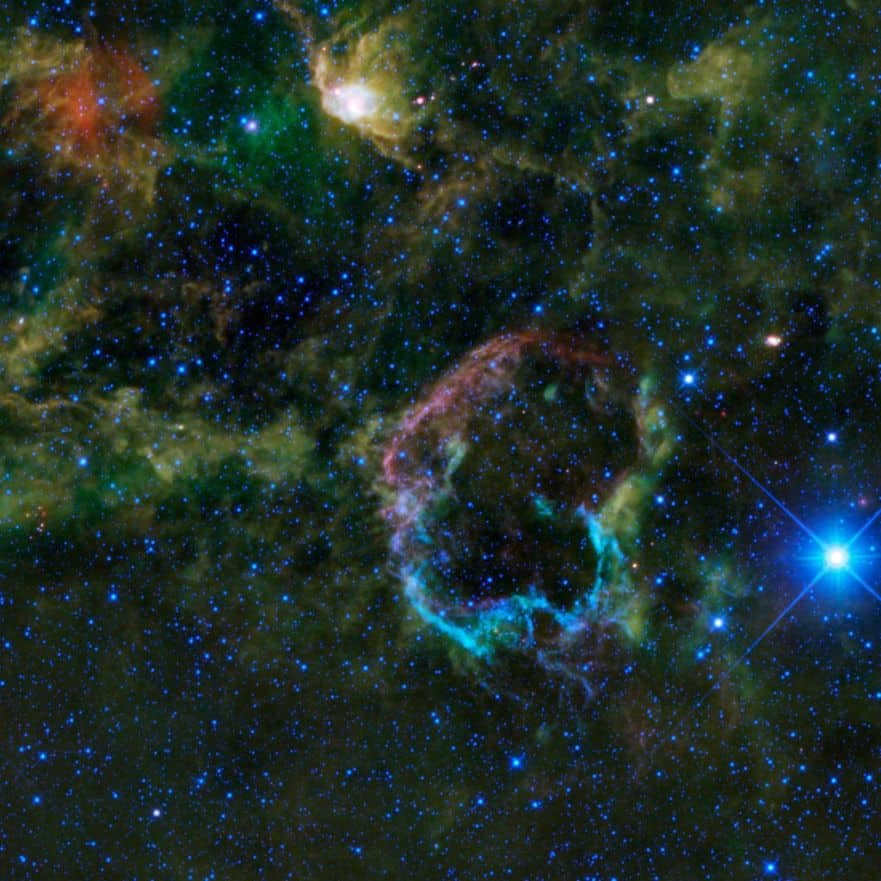
IC 443 stands out because its envelope is divided into two distinct halves, each with its own unique radius, structure, and emission properties. The larger northeastern half, shown in a vibrant purple hue in the upper left corner, consists of delicate, sheet-like filaments that emit light from a combination of neon, iron, silicon, oxygen, and heated dust particles resulting from the explosion. On the other hand, the southern side, depicted in a bright blue shade below, is formed by denser clumps and nodules that emit light primarily from hydrogen gas and heated dust.
The Medusa Nebula, also known as Sharpless 2-274 or Abell 21, is an awe-inspiring planetary nebula situated near the border of the constellation Canis Minor, the Little Dog. Spanning an impressive distance of 4 light-years, this ancient nebula boasts an apparent visual magnitude of 7.68 and lies approximately 1500 light-years away from us. With a low surface brightness level ranging from 15.99 to 25, observing the Medusa Nebula requires a minimum 8-inch telescope equipped with an OIII filter to enhance visibility.
The object is named “Medusa” due to its resemblance to the serpentine hair of Medusa Gorgon, a character from the myth of Perseus who could turn people into stone with a single glance. George Abell discovered it in 1955.
Initially, it was believed to be a remnant of a supernova until Soviet astronomers in the 1970s confirmed that it is more likely a planetary nebula. This nebula formed when a red giant star underwent a transformation into a hot white dwarf, shedding its outer layers in the process.
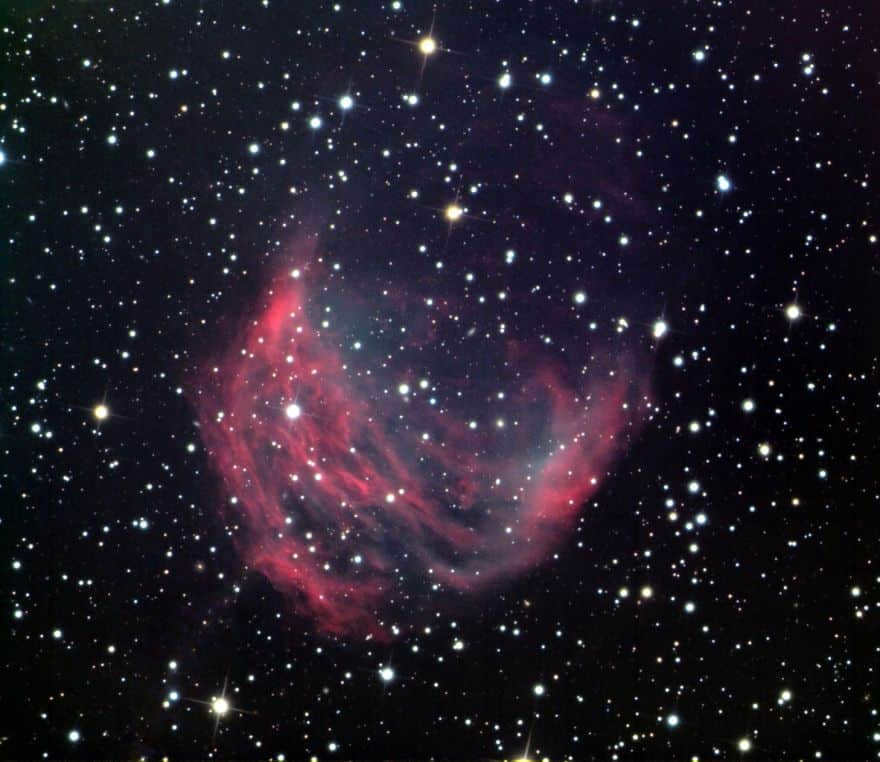
The Medusa Nebula, also known as Abell 21, is a celestial object formed from the remains of a massive star that underwent a supernova explosion approximately 300,000 years ago. Its name, “Medusa,” is derived from the Italian phrase “ghè minga,” meaning “it is not there.” With a visible magnitude of 25.5 and located 815 light-years away, it was initially identified as a source of gamma-ray excess by SAS-2, NASA’s gamma-ray telescope.
NGC 2129 is a youthful open bunch with a visual splendor of 6.7 and a separation of 7200 light-years. It is arranged inside the Local Spiral, a little winding arm of the Milky Way. As far as age, it just arrives at 10 million years of age. The most brilliant stars – two close B-class stars with a similar outspread speed and legitimate movement. Together they are accepted to shape a paired framework.
NGC 2371-2 is a planetary nebula with an obvious visual magnificence of 13 and a separation of 4400 light-years. It is partitioned into two flaps, taking after two distinct articles. This is the reason it is recorded twice in the New General Catalog: NGC 2371 and NGC 2372. It was found by William Herschel.
NGC 2371-2 can be seen in a beginner telescope. It is one of the articles recorded by the Royal Astronomical Society of Canada. The nebula is found southwest of the star Castor.

NGC 2355 is a cluster of stars that are quite old. It has a visual magnitude of 9.7 and is located at a distance of 5,400 light-years. Scientists estimate that it is around a billion years old.
If you want to learn more about the constellation Gemini, you can use our 3D models and online telescope. You can also use a star map, either static or interactive, to explore it on your own.
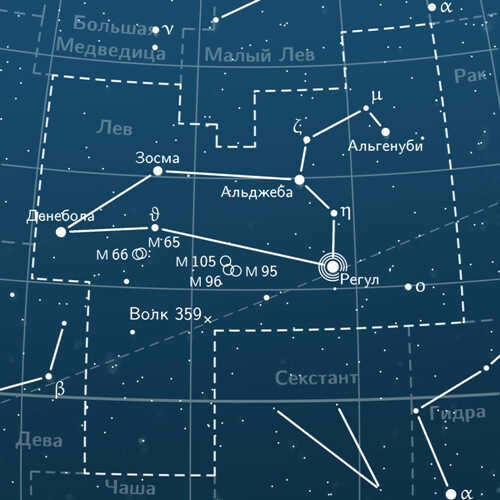
- Alternate name: α of Leo
- Visible stellar magnitude: 1.35
- Distance from the Sun: 77.5 light-years
Regulus, also known as α of Leo, is the most luminous star in the Leo constellation and one of the most brilliant stars in the night sky. It is located approximately 77.5 light-years away from our solar system. Its name, Regulus, originates from the Latin word for “prince.” In Arabic, it is referred to as Kalb al-Asad (قلب الأسد), which translates to “heart of the lion.” Another Latin translation for its name is Cor Leonis. Regulus is classified as a first magnitude star, with a stellar magnitude of 1.35. It is worth noting that the next brightest star, Adara, has a stellar magnitude of 1.50m, making it a second magnitude star.
Regulus is more massive than the Sun, with a mass that is about 3.5 times greater. This star is relatively young, being only a few hundred million years old. It spins at an incredibly fast rate, completing one rotation every 15.9 hours. This rapid rotation causes the star to have a highly flattened shape, similar to that of a pumpkin. In fact, the equatorial radius of Regulus is one-third larger than its polar radius. This unique shape results in a phenomenon known as gravitational darkening, where the star’s poles are much hotter and brighter than its equator. Specifically, the poles are 50% hotter and have five times the brightness per unit surface area. If Regulus were to rotate just 14% faster, the centripetal gravitational force would not be sufficient to counteract the collapsing forces, causing the star to collapse. Interestingly, the axis of rotation of Regulus is almost aligned with its direction of motion in space. Additionally, it has been discovered that the axis of rotation is perpendicular to the line of sight, meaning that we observe Regulus from the side.
9 Deneb
Rephrase the text, making it unique, using the English language while preserving the HTML markup.

- Also known as: α of the Swan
- Visible magnitude: 1.25
- Distance from the Sun: Approximately 1550 light-years
The name Deneb is derived from the Arabic word “dheneb” meaning “tail”, which comes from the phrase ذنب الدجاجة dhanab ad-dajājat, or “tail of the chicken”. This particular star is the brightest in the constellation of Swan, ranking ninth in brightness among stars in the northern hemisphere and twentieth among stars in both hemispheres. Deneb, along with Vega and Altair, forms the “summer-autumn triangle”, which can be seen in the Northern Hemisphere during the summer and fall seasons.
Deneb is one of the most prominent and influential stars in the field of science. Its size is approximately equivalent to the Earth’s orbit, which is about 300 million kilometers. Deneb has an absolute stellar magnitude of -6.5m, making it the most powerful star among the top 25 brightest stars in the sky.
The precise distance to Deneb is still a subject of debate. Most stars at the same distance from Earth are not visible to the naked eye and can only be identified through catalogs, assuming they are known at all. Various internet sources provide values ranging from 1340 to 3200 light years. Recent improvements in parallax measurements suggest a distance estimate of 1340 to 1840 light years, with a most likely value of 1550 light years.
The estimated mass of Deneb is believed to be between 15 and 25 times that of the Sun. Being a white supergiant, Deneb’s high temperature and mass indicate a short lifespan, and it is expected to go supernova within a few million years. The thermonuclear reactions involving hydrogen in its core have already ceased.
Each year, Deneb loses approximately 0.8 millionth of its mass through stellar wind. This is a hundred thousand times greater than the Sun’s equivalent loss.
8 Pollux
Eighth Pollux
Pollux Number 8
The Eighth Pollux
Pollux 8
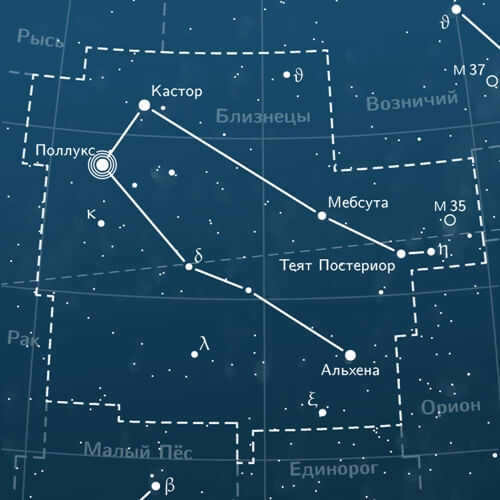
- Also known as: β Gemini
- Visible magnitude: 1.14
- Distance from the Sun: 40 light years
This particular celestial body is named after one of the two brothers known as the Dioscurus, with Polydeucus being his original name (Pollux is the Latinized version). When observing the constellation, one can find Pollux situated on the head of the southern twin.
According to Johann Bayer’s system of classification, the star in question is designated as β Gemini, even though it is actually the brightest star in the constellation. The star that is labeled “Alpha” in Bayer’s system is actually Castor, with an apparent magnitude of 1.57. This is due to the fact that visually, these two stars appear to be almost equally bright. In such cases, where two stars of equal brightness are located close to each other, Bayer’s classification system has a second criterion – priority is given to the star that is more northern in position.
Pollux’s most notable feature is its size. Recent data indicates that its radius is eight times larger than that of our Sun. However, it is predicted that this radius will continue to grow as Pollux undergoes a transformation into a red giant. Astronomical calculations suggest that the star’s supply of helium will be depleted in approximately 100 million years, leading to the transformation of Beta Gemini into a white dwarf.
Furthermore, in 2006, a group of astronomers discovered that Pollux is home to an exoplanet.
Aldebaran 7
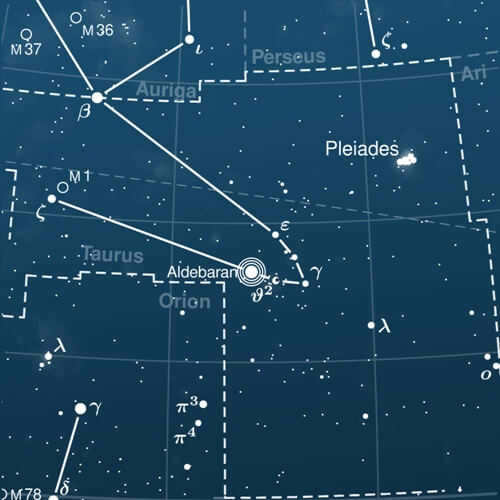
- Also known as: Alpha of Taurus
- Visible brightness: 0.85 (changes)
- Distance from the Sun: 65 light-years
Aldebaran stands out as the most brilliant star among the entire group of stars in the constellations of the zodiac. The name Aldebaran originates from the Arabic word الدبران (al-dabarān), which means “follower” – the star follows the Pleiades on its celestial journey. Due to its position in the head of Taurus, it was given the name Eye of Taurus (Latin: Oculus Taurī). It is also commonly referred to as Palilius and Lamparus.
With a visible sidereal magnitude of 0.85, Aldebaran ranks as the 14th brightest star in the night sky. It has an absolute stellar magnitude of -0.3 and is located at a distance of 65 light-years from Earth.
Aldebaran stands out among the stars in the night sky for a couple of reasons: its luminosity and its position relative to a well-known group of stars. If you trace the path from the three stars that make up Orion’s belt, moving from left to right in the northern hemisphere or right to left in the southern hemisphere, you’ll come across Aldebaran as the first brilliant star along this trajectory.
6 Altair
Rewrite the text, making it unique, using the English language and preserving HTML markup:
6 Altair
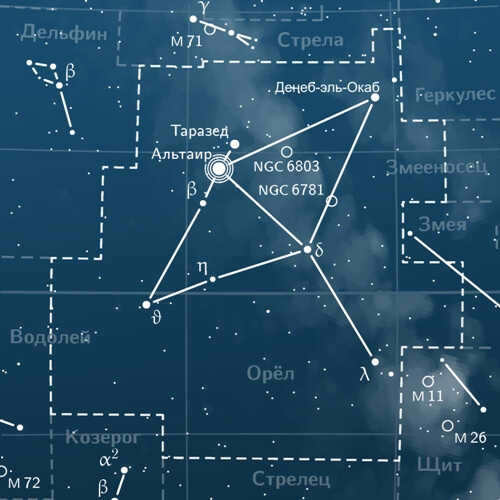
- Also known as: α of Eagle
- Visible magnitude: 0.77
- Distance from the Sun: 18 light years
Altair is a star that can be seen with the naked eye and is known to be one of the closest stars. It is part of a well-known group of stars called the Aquila family, which includes Beta Orla and Tarazed. Altair is also one of the vertices of the Summer Triangle, along with Deneb and Vega.
Altair has an incredibly fast rotation speed, reaching 210 kilometers per second at the equator. This means that Altair completes one rotation in approximately 9 hours. In comparison, the Sun takes more than 25 days to complete one rotation at its equator. This rapid rotation causes Altair to be slightly flattened, with its equatorial diameter being 20 percent larger than its polar diameter.
Altair possesses a spectral category of A7Vn, with a surface temperature measuring 7500° Kelvin, and a luminosity surpassing that of the Sun by 10.6 times. Its mass is equivalent to 1.79 times the mass of the Sun, and its diameter is 1.9 times larger than that of our star.
5 Betelgeuse
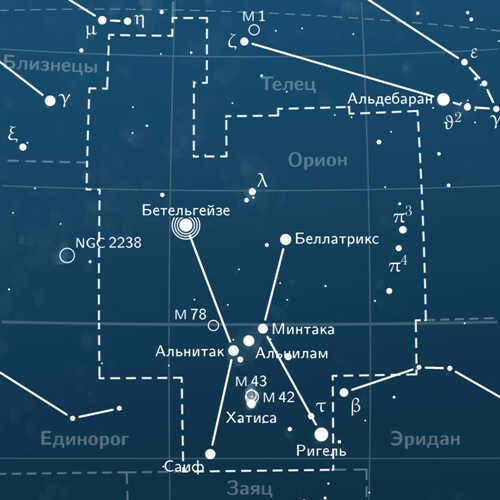
- Also known as: α of Orion
- Visible brightness: 0.50 (variablea)
- Distance from the Sun: 495 to 640 light-years
Betelgeuse is a highly luminous star located in the Orion constellation. It is classified as a red supergiant and exhibits semi-regular variability, with its brightness ranging from 0.2 to 1.2 stellar magnitude. At its minimum luminosity, Betelgeuse is 80,000 times brighter than the Sun, while at its maximum luminosity, it is 105,000 times brighter. Astronomers estimate that the star is located at a distance of 495 to 640 light-years. Betelgeuse is one of the largest stars known, with its size surpassing that of the Sun. If placed in the Sun’s position, it would fill the orbit of Mars at its minimum size and extend to the orbit of Jupiter at its maximum size.
Procyon 4
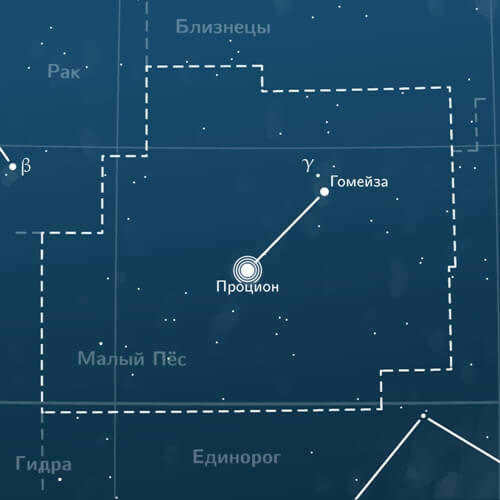
- Alias: α of the Lesser Dog
- Observable stellar magnitude: 0.38
- Distance from the Sun: 11.46 light years.
To the naked eye, Procyon appears as a solitary star. However, Procyon is actually a binary star system comprised of a primary white dwarf known as Procyon A and a dim white dwarf called Procyon B. The brilliance of Procyon is not due to its luminosity, but rather its close proximity to the Sun. Procyon stands out in brightness not because of its luminosity, but because of its nearness to the Sun. This system is positioned at a distance of 11.46 light-years (3.51 parsecs) and is among our nearest celestial neighbors.
The etymology of the name Procyon is quite intriguing. It is derived from centuries of careful observation. The literal translation from Greek is “before the Dog”, while a more poetic translation would be “herald of the dog”. The Arabs referred to it as “Sirius, the shedder of tears.” All of these names are directly linked to Sirius, a star that was revered by numerous ancient civilizations. It is not surprising that while gazing at the night sky, they noticed Procyon as a precursor to the rising of Sirius. Procyon appears in the sky 40 minutes earlier, almost as if it is racing ahead. If you were to depict the constellation Canis Minor, Procyon would be situated on its hind legs.
Procyon is the eighth brightest star in the night sky, shining like 8 of our Suns. Its luminosity is 6.9 times that of the Sun. The star is also much larger than our Sun, with a mass 1.4 times that of the Sun and a diameter 2 times that of the Sun. Additionally, it is currently moving towards the solar system at a speed of 4,500 meters per second.
Locating Procion is an easy task. Simply face south and locate Orion’s belt with your naked eyes. Once you have found the belt, draw an imaginary line from the lower star of the belt towards the east. Additionally, you can use the larger constellation Gemini to orient yourself. The Small Dog constellation is situated below Gemini in relation to the horizon. Spotting Procyon within the Dog constellation is not challenging as it is the only bright object and its radiance is quite captivating. Keep in mind that the Small Dog constellation is equatorial, meaning its position above the horizon varies depending on the time of the year. Winter is the optimal time to observe it.
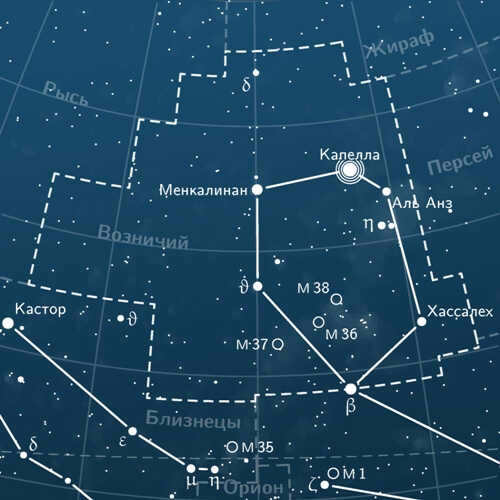
- Alternative title: α of Ascendant
- Visible stellar magnitude: 0.08
- Distance from the Sun: 42.6 light years
Capella is the brightest star in the Ascendant constellation, the sixth brightest star in the night sky, and the third brightest in the sky of the Northern Hemisphere.
Capella (Latin Capella – “Goat”), also known as Capra (Latin Capra – “goat”), or Al Hayot (Arabic العيوق – “goat”), is a yellow giant star. It is situated on the shoulder of the Ascendant constellation according to its depiction. In sky maps, a goat was often depicted on this shoulder of the Ascendant. Capella is located closer to the North Pole than any other first-magnitude star (Polaris is only of second magnitude) and holds significant importance in numerous mythological tales due to this placement.
Capella is of interest from an astronomical perspective because it is a double star with two giant stars belonging to spectral class G. These stars have luminosities of approximately 77 and 78 times that of our Sun. They are separated by a distance of 100 million kilometers, which is about 2/3 of the distance between the Earth and the Sun, and they rotate every 104 days. The first star, Capella Aa, is the dimmer of the two and has already evolved from the main sequence. It is currently in the red giant phase, with the processes of helium burning occurring within its core. The second star, Capella Ab, is brighter and has also moved past the main sequence. It is currently in the “Hertzsprung gap,” a transitional stage of stellar evolution where the fusion of helium from hydrogen in the core has ended but helium burning has not yet begun. Capella is also a source of gamma rays, potentially due to magnetic activity on the surface of one of its components.
The stars have roughly the same mass, with each star weighing around 2.5 times the mass of the Sun. In the future, as they expand into red giants, the outer layers of the stars will likely expand and may even come into contact with each other.
The central stars also have a dim companion, which itself is a binary system consisting of two red dwarf stars of the M-class. These stars orbit the main pair in a wide orbit that spans about one light-year in radius.
Between 210,000 and 160,000 B.C., Capella held the title of the brightest star in the sky. Before Capella, Aldebaran held this position, and after Capella, Canopus took over as the brightest star in the sky.
2 Vega
Rephrase the text, making it unique, using the English language and keeping the HTML markup.
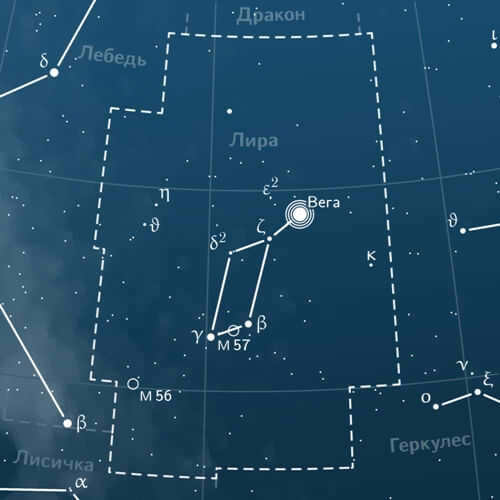
- Also known as: α Lyra
- Apparent brightness: 0.03 (variable)
- Distance from the Sun: over 25.3 light years
During the summer and autumn seasons, stargazers in the northern hemisphere can spot the Great Summer Triangle in the night sky. This well-known group of stars is called an asterism and consists of Deneb, Altair, and Vega. Vega, the brightest star in the constellation Lyra, shines with a beautiful blue color and is situated at the top of the Triangle.
The word “Vega” is derived from the Arabic phrase النسر الواقع (an-nasr al-wāqi’), which translates to “falling eagle” or “falling vulture”.
Vega, often referred to as “possibly the most significant star after the Sun” by astronomers, is currently the most extensively studied star in the nighttime sky. It was the first star (excluding the Sun) to be captured in a photograph and to have its emission spectrum analyzed. Vega was also among the initial stars to have its distance calculated through parallax. In the measurement of stellar magnitudes, Vega’s brightness has traditionally been considered zero, serving as a reference point. It is one of the six stars that establish the foundation of the UBV-photometry scale, which measures a star’s emission across various parts of the spectrum.
Vega spins at a very high velocity around its axis, reaching a rotational speed of 274 km/s at the equator. The rotation of Vega is a hundred times faster, resulting in an ellipsoidal shape. The temperature of Vega’s photosphere is not uniform, with the highest temperature located at the star’s pole and the lowest temperature at the equator. Currently, Vega is observed from Earth in a nearly polar direction, giving it a bright blue-white appearance. Recent observations have detected asymmetries in Vega’s disk, suggesting the possible presence of a planet approximately the size of Jupiter.
In the 12th century BC, Vega served as Polaris and will resume this role in 12,000 years. The shift of Polaris is caused by the Earth’s axis precession phenomenon.
1 Arcturus
Arcturus, also known as Alpha Boötis, is the brightest star in the constellation Boötes. It is a red giant star located approximately 37 light-years from Earth. Arcturus is one of the largest and brightest stars in the night sky, with an apparent magnitude of -0.04. It is easily visible to the naked eye and has been used for navigation and timekeeping for centuries. Arcturus is also a popular target for amateur astronomers due to its unique properties and proximity to Earth.
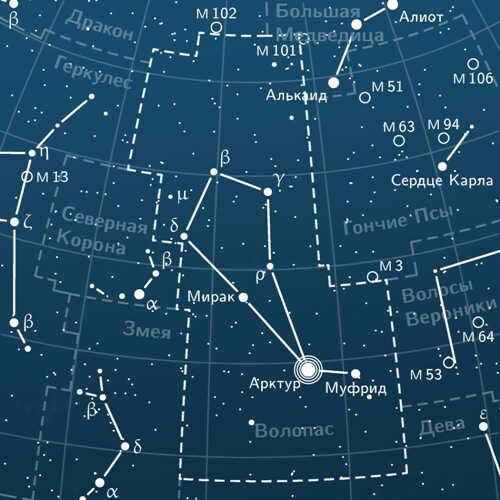
- Alternate name: α of Volopassus
- Visible stellar magnitude: -0.05 (variable)
- Distance to the Sun: 36.7 light years
Arcturus (Alrameh, Azimeh, Colanza) is the most luminous star in the Volopassus constellation and the northern hemisphere, and the fourth brightest star in the night sky after Sirius, Canopus, and the Alpha Centauri system. Arcturus has an apparent stellar magnitude of -0.05m. It is part of the Arcturus star stream, which, according to Ivan Minchev from the University of Strasbourg and his colleagues, is believed to have formed when the Milky Way absorbed another galaxy approximately 2 billion years ago.
Arcturus is a highly visible star that can be easily located in the night sky. It can be seen from any location north of 71° south latitude, thanks to its relatively low north declination. To locate Arcturus, you can trace a curved path through the three stars that form the handle of the Big Dipper – Aliot, Mitsar, and Benetnash (Alkaid).
Arcturus, similar to more than 50 other stars, resides within the Arcturus Stream, a collection of stars with varying ages and metallicities that are all moving in similar directions and speeds. Due to the stars’ high velocities, it is plausible that they were once captured and assimilated into the Milky Way along with their parent galaxy. Hence, Arcturus, a prominent and relatively close star to our own, may have originated from outside our galaxy.
The star’s name is derived from the Greek word Ἀρκτοῦρος, ἄρκτου οὖρος, which translates to “Guardian of the Bear.” According to Greek mythology, Arcturus is associated with Arcadus, who was placed in the sky by Zeus to protect his mother, the nymph Callisto, who was transformed into a bear (represented by the constellation Ursa Major). Another version of the myth suggests that Arkad is the constellation Volopassus, with Arcturus being its brightest star.

